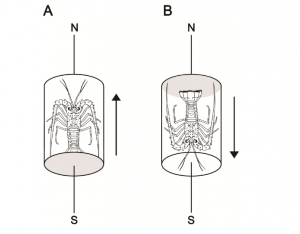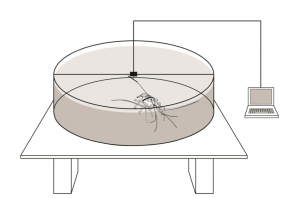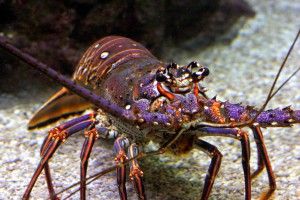Although, we humans must rely on compasses and google maps to guide us, a diverse range of animals possess the incredible ability to detect the earth’s magnetic field, allowing them to migrate accurately over astonishing distances. These animals are able to use this geomagnetic field to acquire both directional or “compass” information to maintain consistent headings, and positional or “map” information to change directions at the right places in a migratory route.
The exact way animals do this remains a mystery. However, several theories exist that hypothesize how animals might detect these magnetic fields. One popular theory suggests that small magnetite crystals within the animal might twist into alignment with the magnetic field, activating sensory receptors called magnetoreceptors, providing the animal with information about its orientation. By applying a strong magnetic pulse in the right direction, the magnetic dipole moment of the small magnetite crystal can be realigned, potentially causing incorrect directional and positional information to be transduced to the nervous system of the animal, changing its orientation behavior.
Magnetic pulses have only been shown to alter orientation behavior in vertebrate animals, thus far. However, researchers David Ernst and Kenneth Lohman of the University of North Carolina investigated the effects of strong magnetic pulses on the unique Caribbean spiny lobster, Panulirus argus, the only invertebrate species known to have both magnetic directional and positional (compass and map) senses. Additionally, permanently magnetic material thought to be magnetite had been found in the Caribbean spiny lobster, in a previous study. To determine whether these magnetic particles are associated with magnetoreception in the spiny lobster, the researches subjected the lobsters to strong magnetic pulse treatment and observed their orientation behavior.
Lobsters that were subjected to a magnetic pulse delivered parallel to earth’s magnetic horizontal field (toward magnetic north) walked westward after exposure to the magnetic pulse. Lobsters that were subjected to a magnetic pulse delivered antiparallel to the horizontal field (toward magnetic south) walked northeast. The control group of lobsters that were handled similarly but not subjected to the magnetic pulse walked in random directions with no significant orientation.

Magnetic pulse treatment. Lobsters were placed tail first into the solenoid (represented by the cylinder) of the magnetizer.(A) parallel magnetic pulse condition (B) antiparallel magnetic pulse condition (N=North; S=South)
The results indicate that the magnetic pulse did affect orientation behavior in the spiny lobster by causing them to have a significant directional preference based on the way the magnetic pulses were administered to the animal relative to the earth’s magnetic field. This supports the hypothesis that Caribbean spiny lobsters have magnetite-based magnetoreceptors which are affected by the magnetic pulse treatment used in this experiment.

Orientation Arena. Lobsters were tethered within a circular arena to an electronic tracking system, and a computer that monitored the angle of orientation.
Not only does this study add support for the magnetite-based magnetoreceptor hypothesis for how animals use the earth’s magnetic field to orient themselves, it is particularly important as a pioneering study into magnetic sensory reception in invertebrate animals.
Source: Ernst, D. A., & Lohmann, K. J. (2016). Effect of magnetic pulses on Caribbean spiny lobsters: implications for magnetoreception. Journal of Experimental Biology, jeb-136036.

